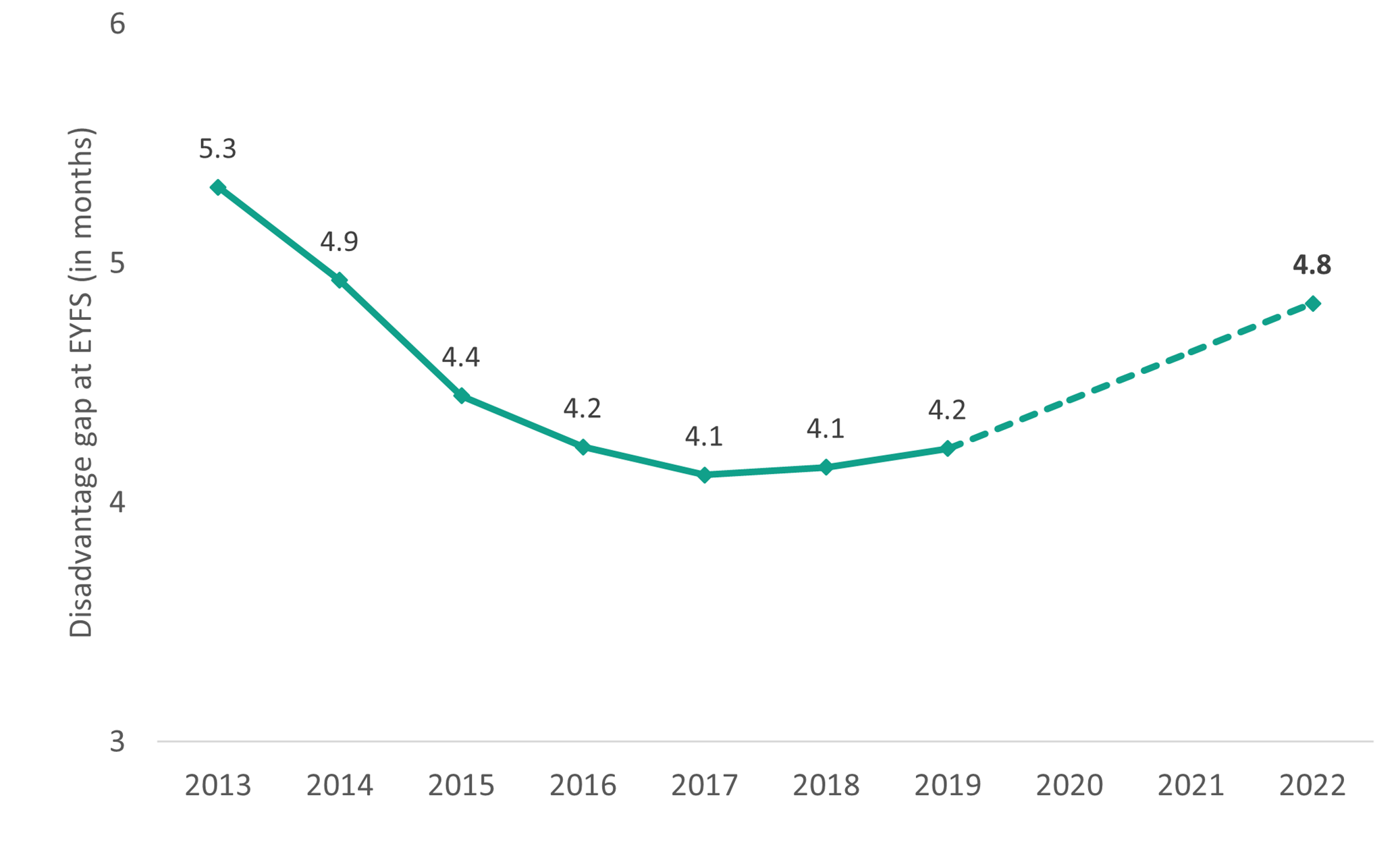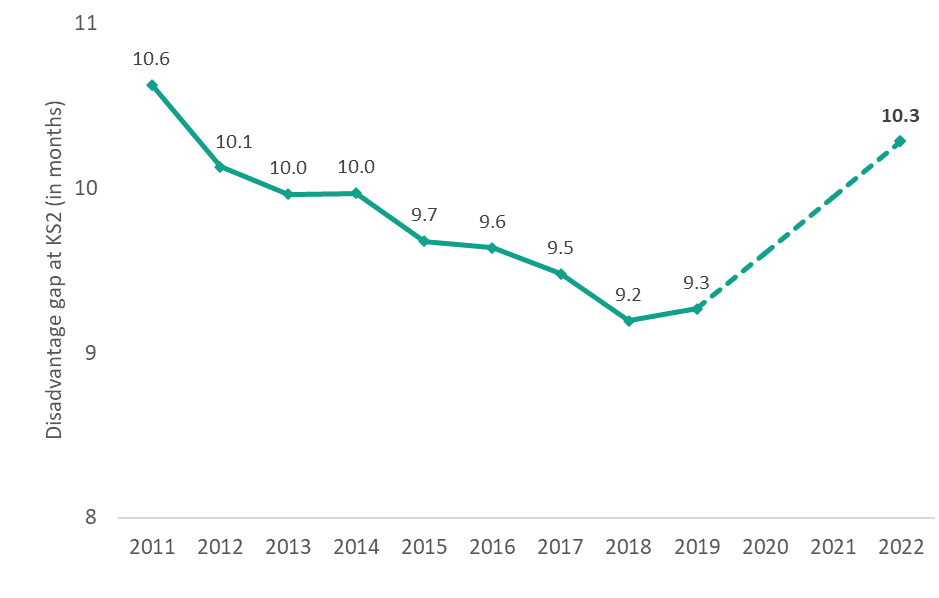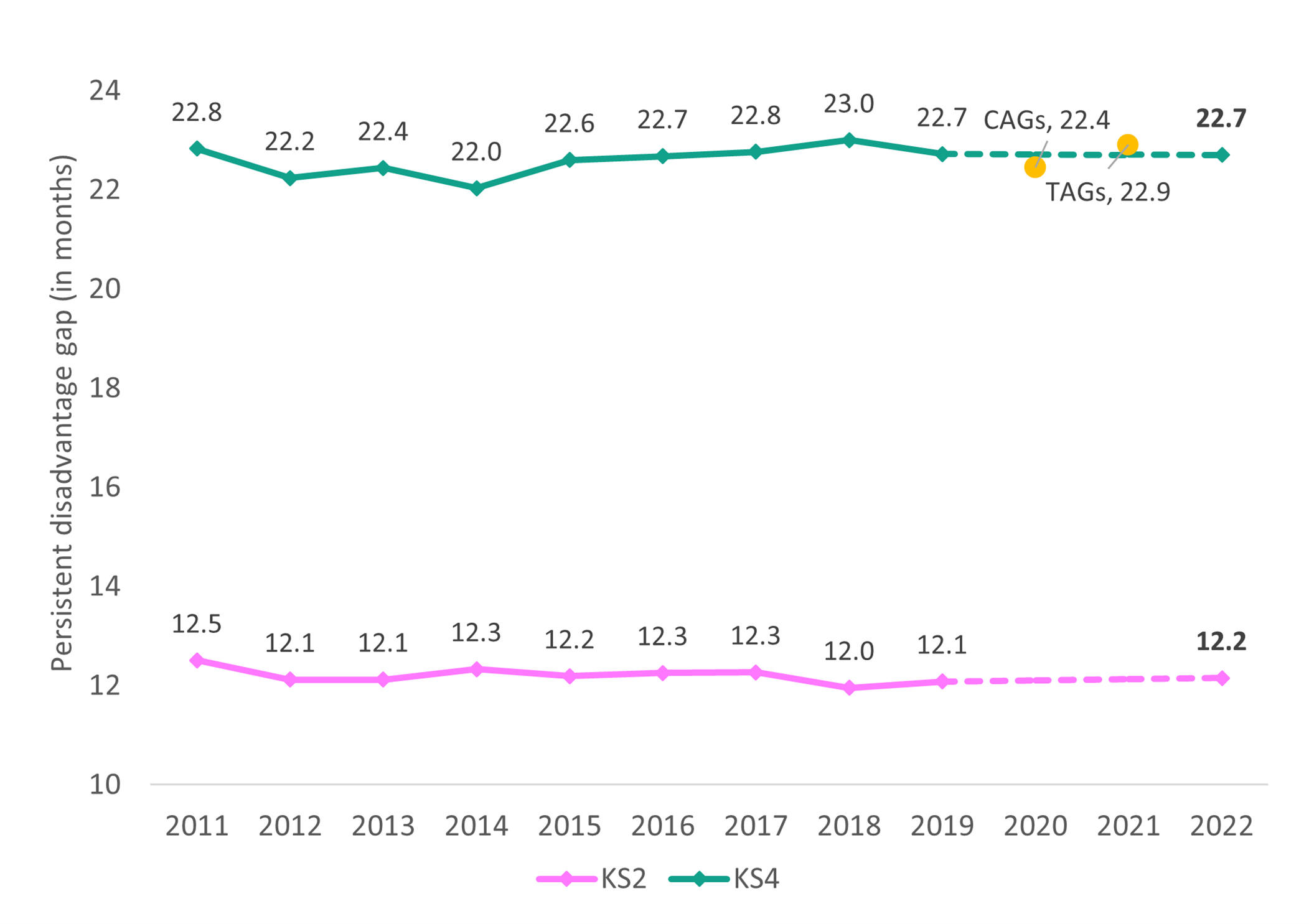Disadvantage
Early years foundation stage
Disadvantaged pupils have, on average, lower attainment, than other pupils and this disadvantage gap widens as pupils progress in their education. In 2022, the disadvantage gap among pupils aged 5 was 4.8 months, up from 4.2 months in 2019. This increase comes after a sustained period (2016-2019) where the gap had remained broadly stable at just above 4 months. The post-pandemic gap of 4.8 months – the largest since 2014 – is a setback, given the earlier progress in narrowing the gap during 2013-2016.
Figure D1: The disadvantage gap for pupils in reception year widened in 2022 to its highest level since 2014

|
How do we measure the disadvantage gap? We measure the disadvantage gap by comparing the attainment of disadvantaged pupils and their non-disadvantaged peers. For pupils in reception year, we define disadvantage as being currently eligible for free for school meals (FSM), and for older pupils, being FSM eligible at any point in the previous six years. At each key stage, we order pupils by their attainment results and use this to assign them a rank. We then calculate the average rank of non-disadvantaged and disadvantaged pupil groups and the difference between the two (known as the ‘mean rank difference’) is converted into a months of learning gap. This is our measure of how far behind disadvantaged pupils are from their peers. |
Primary school
The disadvantage gap at the end of primary school increased between 2019 and 2022 from 9.3 to 10.3 months –the second largest gap since the start of our series in 2011, when it was 10.6 months. Following sustained progress in narrowing the gap from 2011 to 2018, the gap increased slightly in 2019 even prior to the pandemic, and then substantially increased in 2022, wiping out nearly all the earlier progress. Based on the historic rate of progress in gap-narrowing prior to the pandemic, the Department for Education expects that it may take another ten years to simply return the gap to the level it was in 2019.[1]
Figure D2: The disadvantage gap at the end of primary school widened in 2022 to above its 2012 level, wiping out a decade of progress in narrowing the gap

[1] House of Commons Committee of Public Accounts. “Education recovery in schools in England.” 22 May 2023. https://committees.parliament.uk/publications/40220/documents/196416/default/.
Secondary school
One-quarter of pupils are defined as disadvantaged by the end of secondary school, a smaller proportion than the 29 per cent of pupils at the end of primary school. This is because, as children get older, their parents are more likely to enter work and exceed the earnings threshold for free school meal eligibility. The disadvantage gap in GCSE English and maths widened to 18.8 months in 2022 – its largest since 2012. Following good initial progress in narrowing the gap between 2011 and 2014 (from 19.7 months to 18.2 months), the gap then remained at around 18 months in the years leading up to the pandemic.
Figure D3: The disadvantage gap in GCSE English and maths widened in 2022 to its largest level since 2012

Persistent disadvantage
In our previous reports we have shown not only that disadvantaged pupils tend to do worse than their peers but that those who are disadvantaged for the longest time do worst of all.[1] Here we consider attainment gaps for persistently disadvantaged pupils – comprising 14 per cent of pupils by the of primary school and 11 per cent by the end of secondary.
[1] Education Policy Institute. “Covid-19 and Disadvantage Gaps in England 2021.” 15 December 2022. https://epi.org.uk/publications-and-research/covid-19-and-disadvantage-gaps-in-england-2021/.
| How do we measure the persistent disadvantage gap?
Whilst there is no official definition of pupils in long-term poverty, we define this group as pupils who are eligible for free school meals for 80 per cent or more of their school lives. We are able to identify these pupils in the National Pupil Database by using pupils’ school census records in the spring term to create a longitudinal picture of each pupil’s length of time being eligible for FSM. We can then measure the persistent disadvantage gap in a similar way to our headline disadvantage gap measure (see box above) by comparing the attainment of persistently disadvantaged pupils with their non-disadvantaged peers. Note it is not possible to create this measure for pupils in reception year (for whom we do not have FSM history) and the nature of the persistence changes across key stages – being FSM-eligible for 80 per cent of a pupil’s time in school by the end of secondary school is a longer period of time than for a pupil at the end of primary school. |
Primary and secondary school
The persistent disadvantage gap at the end of primary school in 2022 was 12.2 months, similar to the 2019 gap of 12.1 months. This is the highest the gap has been since 2017 and matches the long-run average over the period 2011-2019.
In 2022, the persistent disadvantage gap at the end of secondary school was 22.7 months – unchanged from 2019, the latest year unaffected by the pandemic and virtually unchanged since 2011 (at 22.8 months). As for key stage 2, this indicates that, there has been a lack of progress in gap-narrowing for persistently disadvantaged pupils over the last decade.
Figure D4: There has been no progress in closing the persistent disadvantage gap over the last decade across key stages – persistently disadvantaged pupils are over one year behind their non-disadvantaged peers by the end of primary school and almost two years behind by the end of secondary school
The impact of Universal Credit
We have previously reported that the persistence of disadvantage appears to have been increasing among the group of disadvantaged pupils even prior to the pandemic and cost of living crisis.2 This is a potentially concerning trend and one that is consistent with wider evidence of rising child poverty.[1] But understanding what is happening to the persistently disadvantaged group has been complicated by wider changes to the welfare system with the roll out of Universal Credit, summarised below and discussed in more detail here.[2]
[1] Carey Oppenheim. “Changing Patterns of Poverty in Early Childhood.” 14 September 2021. https://www.nuffieldfoundation.org/publications/changing-patterns-of-poverty-in-early-childhood.
[2] National Foundation for Educational Research. “Measuring Pupil Disadvantage: The Case for Change.” 8 March 2023. https://www.nfer.ac.uk/publications/measuring-pupil-disadvantage-the-case-for-change/.
| How is Universal Credit affecting free school meal eligibility?
Universal Credit (UC) is a social security benefit which was introduced in April 2013 to replace six existing means-tested benefits, aimed at ensuring people are better-off in work. Prior to April 2018, UC claimants with school-aged children were eligible to claim FSM. From April 2018, an income threshold was introduced so that new UC claimants were only eligible if they earned less than £7,400 per year. To ease this transition, the government put in place protections during the period of UC roll out. This meant that any pupil eligible for FSM (and subsequently eligible) would retain free school meals until at least March 2025 – even if their family income increased above the threshold during that time. This this means that since 2018, there has been an increasing number of pupils who are eligible for FSM due to transitional protections rather than their financial circumstances. This will not affect our headline disadvantage gap measure until 2024, as this is based on being eligible for FSM in the last six years which creates a six year lag. But it does mean that each year from 2019 onwards, our persistently disadvantaged group will be capturing a more transient, higher-attaining group over time (as some of these pupils would have otherwise become ineligible for FSM, had it not been for the UC protections). It consequently becomes harder to interpret our persistent disadvantage gap over time as a measure of changes in underlying attainment for the poorest pupils, as the composition of the group itself is changing. |
Despite the persistently disadvantaged group capturing a generally higher-attaining group of pupils in recent years (see box above), we have seen that the persistent disadvantage gap – as measured using FSM eligibility – has not changed between 2019 and 2022. This suggests that the underlying gap may have worsened in the absence of UC protections. One way to explore the impact of UC protections is to remove cases where FSM eligibility could potentially have been affected by the protections.[1] When we recalculate our persistent disadvantage gap measure at the end of secondary school for this subgroup, we do indeed see some evidence of worsening educational outcomes for persistently disadvantaged pupils between 2019 and 2022.
Figure D4: Using an alternative persistent disadvantage gap measure which adjusts for the impact of Universal Credit protections suggests worsening GCSE attainment for the poorest pupils since 2019

[1] Specifically, any years in which pupils may be benefiting from transitional protections are not used in calculating the persistent disadvantage gap. This alternative measure involves discarding FSM years in cases where we are uncertain if the pupil is eligible due to UC protections or due to their financial circumstances. Years up to 2018 are unaffected on this measure because we base our data on the January census which pre-dates the introduction of UC protections in April 2018.

